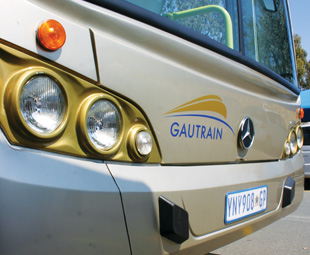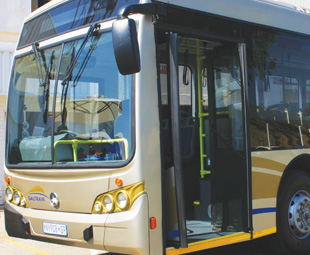Gautrain ghost buses

The Gautrain bus service isn’t being used anywhere close to its full potential. Many of its buses run without any passengers and if you haven’t noticed this before, you will notice it now. Could this lead to the downfall of the Gautrain system as a whole? BLAIR BURMEISTER uncovers some frightening facts.
The Gautrain transport system was intended to provide a safe, efficient and reliable commuting option for those in Gauteng. It incorporates a bus service that transfers passengers between cities, surrounding suburbs and business hubs, whether they make use of the trains or not.
The system is supported by advanced bus service infrastructure. The ticketing facility means no cash transactions, allowing passengers to catch respectable buses in a safe environment and in a rapid manner. This is meant to be hassle-free travelling. But few commuters are using the bus service, and its seems too little effort is being made to attract new passengers.
Gautrain management wants 108 000 train passengers to be using that service a day by the end of January 2013 – in other words, within the next two months.
Yet according to Kelebogile Machaka, media and communications manager for the Bombela Operating Company, the trains currently serve 39 000 to 40 000 passengers a day, while the buses transport 14 000 to 15 000 passengers per day.
So there clearly is cause for concern – but who needs to be concerned?
Empty buses no stress for Bombela
The Gautrain buses may be operating as empty vessels but this is no stress for Bombela, the company responsible for managing, operating and partly financing the project. If too few passengers use the service, as was apparently anticipated at the outset, Bombela receives a government subsidy to make sure it doesn’t run at
a loss.
Barbara Jensen, spokesperson for Gautrain management, says the guarantee was provided because the project was the first of its kind in South Africa and the market was untested. She was unable to provide an estimate of the figures involved because the length of each trip is a factor in determining the revenue needed for the patronage guarantee … but you can be sure someone knows.
And the problem with built-in, guaranteed safety nets is that it’s so easy to rely on them – where is the motivation to increase passenger numbers?
Capacity versus demand
Machaka says approximately 30 percent of Gautrain passengers make use of the bus system: “This is above the global average for other similar systems.”
She adds that the huge majority of passengers use Gautrain services during peak hours – and acknowledges that there is spare capacity during the off-peak hours of 09:00 to 15:00. “Our aim is to promote ridership during off-peak periods,” she says. “This goes for both trains and buses.”
With this aim, and the ambitious goal of getting so many more passengers to use the buses, you’re no doubt wondering what is being done to promote the service.
Machaka explains: “Bombela has rolled out a marketing and advertising campaign aimed at educating the public as to the convenience and cost effectiveness of using Gautrain train and bus services. This campaign is ongoing and has incorporated full above- and below-the line interventions – from television and radio adverts, communication with passengers via sms, social media, and e-mail, to regular meetings with interested and affected parties.”
As a journalist, I need to go to all sorts of off-route places at different times of the day, but technically I fall within the target market – yet none of the “interventions” that are part of the ongoing campaign have reached me as yet.
An informal survey revealed that I am not alone. One colleague who has used the service said the bus was on time, in mint condition, and driven by a polite and friendly bus driver – but she was the only passenger on the trip from Fourways to Sandton in rush-hour traffic. “The carbon emissions of a big luxury bus!” she said. “And me as the only passenger … ”
Imagine seeing packed-to-capacity Gautrain buses. That is the goal. It’s a case of over-capacity and very little demand – so it will be interesting to see what Gautengers get in terms of the specific marketing and brand activation campaigns designed to get them taking the bus.
Addressing the public transport phobia
Because of the cost of the service, those in the middle to upper income bracket form the core of the Gautrain target market – and the use of privately owned cars, often with just one occupant, is something the Gautrain system aims to get people to move away from.
But the service hasn’t done much to reduce the public transport phobia that is evident among those in these income brackets.
 “Sometimes it takes time for Joe Soap to change his lifestyle,” says Machaka. “But the days of every middle class office worker driving to work by himself in his own car are definitely numbered. It doesn’t happen in big cities elsewhere in the world, and it cannot continue here,” she says.
“Sometimes it takes time for Joe Soap to change his lifestyle,” says Machaka. “But the days of every middle class office worker driving to work by himself in his own car are definitely numbered. It doesn’t happen in big cities elsewhere in the world, and it cannot continue here,” she says.
Public transport services in cities such as Paris, New York and London provide the convenience of seamless integration because they have co-ordinated, reliable systems. Spot-on scheduling, strong information systems and efficient ticketing processes all add to the smooth running of these cities, ultimately contributing to a stronger economy.
To be fair, it’s not right to compare Gauteng to the likes of Paris and New York. Their public transport systems have been in existence for far longer, their bus drivers don’t strike and 45-minute delays are unlikely.
And it’s an accomplishment that an advanced transport infrastructure such as the Gautrain has made its way to the bottom of Africa – in essence, it’s a fantastic system, one that has worked for many other world-class cities.
But it’s a fact that using trains and buses is an unfamiliar experience for many in Gauteng. Their wariness about trying them out could be rooted in perceptions of safety risk, concerns about reliability, the inconvenience and possibly expense of getting to a train or bus station, and image … traditionally, the more well-off members of South African society have not used public transport.
So Machaka may have a point about Joe Soap, but while the days may be numbered for private-individual motorised transport in other global cities, South Africa still has a long way to go.
Changing people’s perceptions of public transport will take time, and the first and most pivotal requirement is for the Gautrain system to be able to deliver reliability. Without reasonable assurances of reliability, the system is not going to get people out of their cars and the ghost-bus scenario will continue.
The reliability factor
A series of Gautrain bus driver strikes in 2011 and 2012 saw the service come to a halt on numerous occasions. According to Machaka, when Gautrain bus drivers went on strike over transport allowances in February, 12 000 passengers were left stranded in one day. “This resulted in a 10 percent drop in passengers,” she says. As a result, 318 bus drivers were fired. Replacement drivers were employed, but were subsequently intimidated with instances of arson and stoning of buses.
“The strikes resulted in huge inconveniences to passengers,” Machaka acknowledges. “At the time, we tried to operate a skeleton service to ensure commuters weren’t left stranded, but these efforts were unfortunately met by intimidation and violence on the part of the striking workers.”
Irate commuters used social networking sites to complain, and many are still complaining about various grievances – notably about delays even when there are no strikes.
The Gautrain Facebook page is awash with moans and groans about the bus system. Many have complained about the long wait at stops, sometimes being forced to wait for 45 minutes at a time. Commuters complained about missing exams or work, or having to pay an additional fare for an alternate mode of transport. The buses are meant to run at 12-minute intervals.
Machaka says this problem is due to the lack of dedicated bus lanes, which means buses are subjected to the same traffic conditions as other motorists. “This particularly impacts on scheduling during peak times,” she says.
She adds that passengers are notified of delays via various applications off numerous communication platforms.
However, according to heated posts on its Facebook page, the Gautrain Blackberry application, which was introduced to convey information about delays, isn’t updated regularly and is often behind. Many passengers raised the question as to whether the service will ever run efficiently.
While passengers may understandably have seen the strikes and accompanying intimidation as a safety risk, the system’s lack of consistency is the major issue; people simply can’t afford to add 45 minutes of waiting time to the journey to work, or wherever they might be going.
The issue is inefficiency, and it’s making many of those who have been willing to give the system a try turn to – or return to – other transport options, including their own cars, which is what the Gautrain system aims to get people to move away from.
It’s bums on bus seats that the Gautrain system needs, and those in charge need to do all they can to achieve that goal.
Published by
Focus on Transport
focusmagsa




